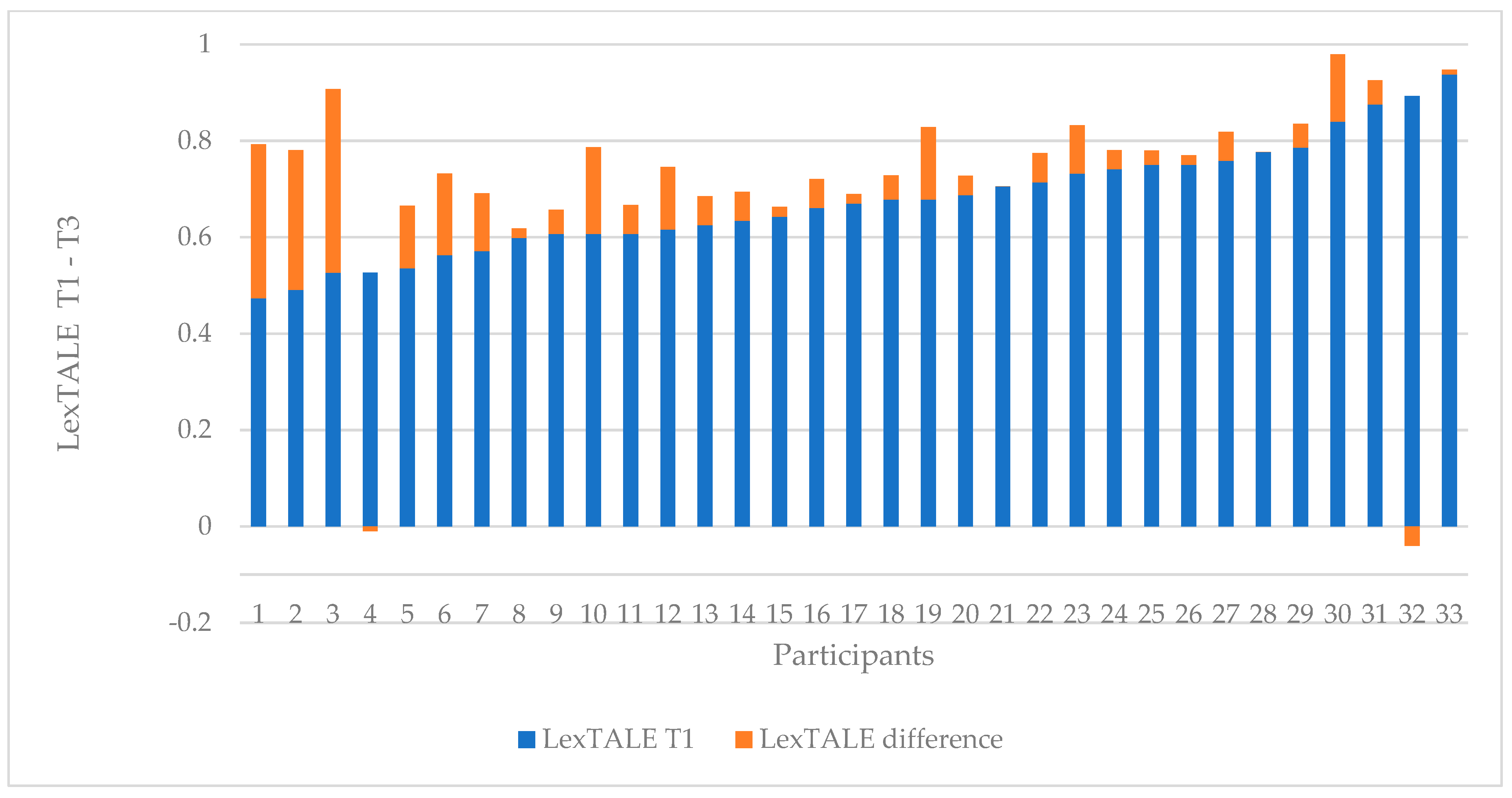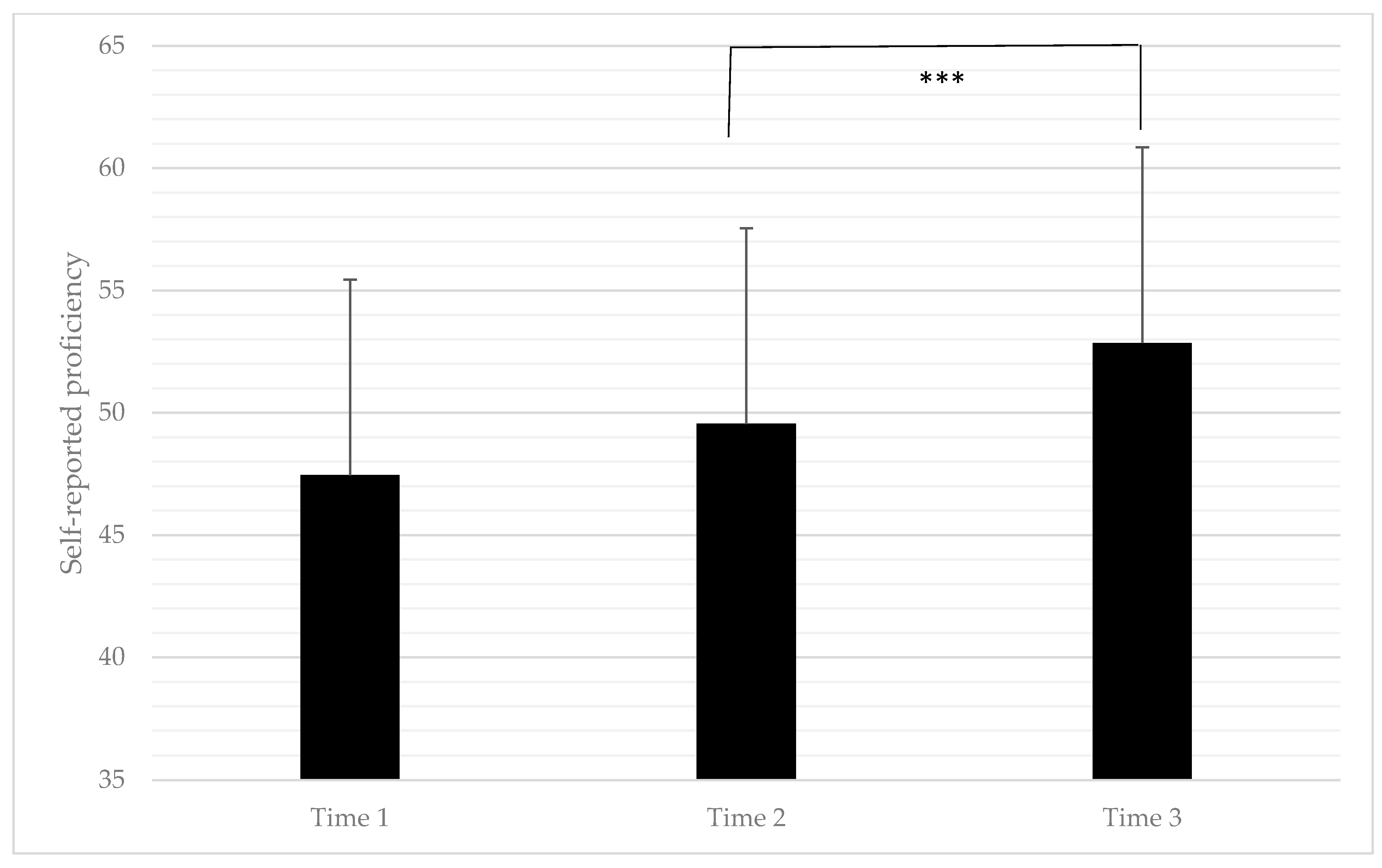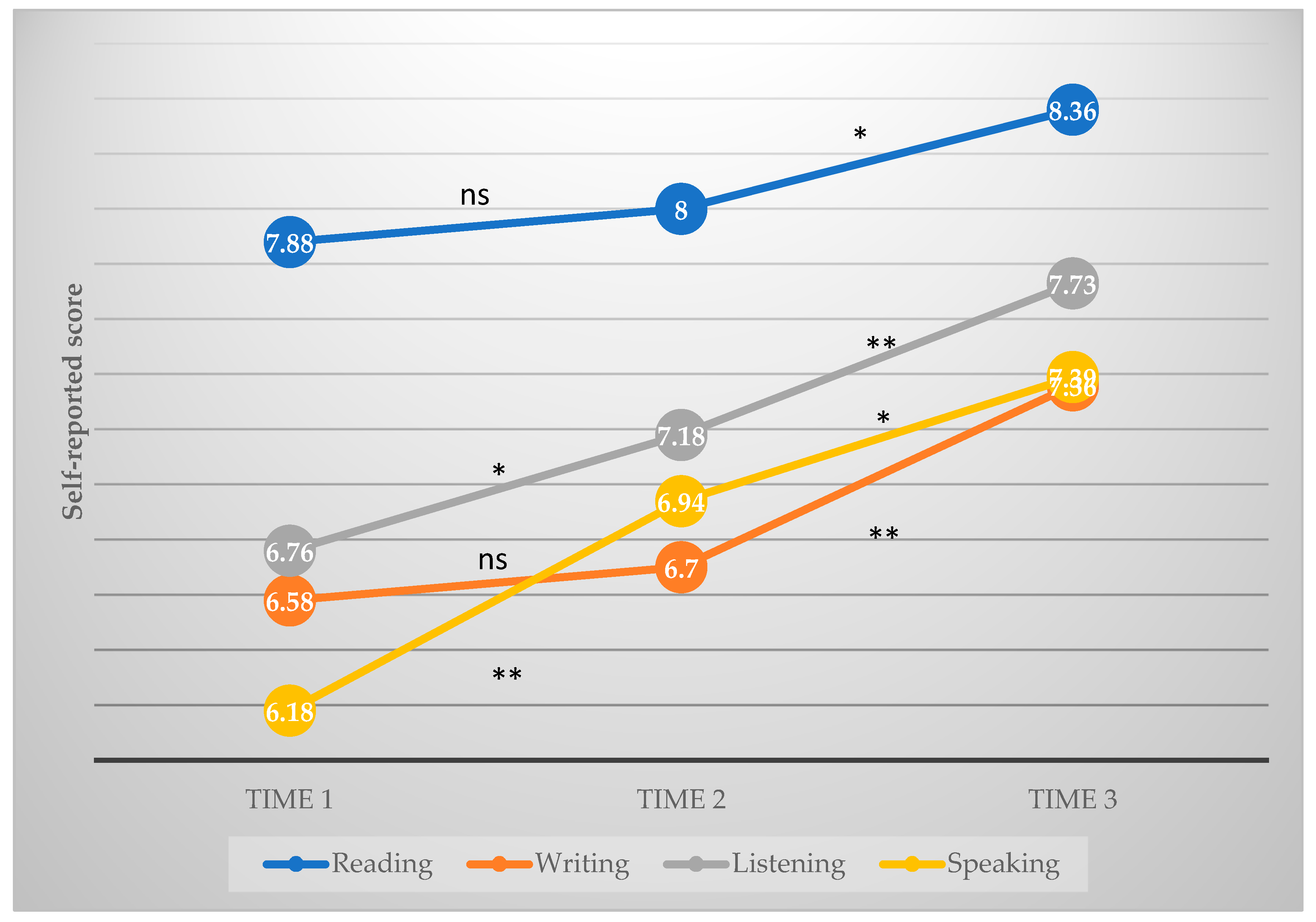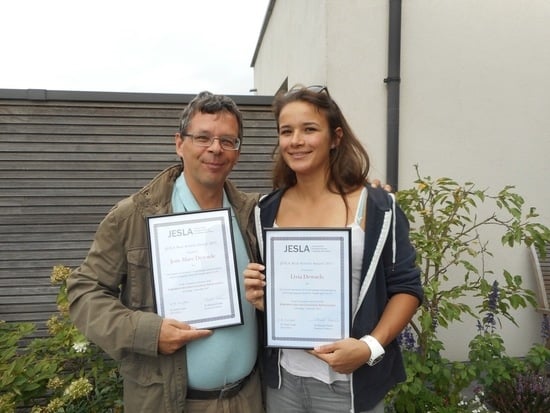Actual and Self-Perceived Linguistic Proficiency Gains in French during Study Abroad
Abstract
1. Introduction
2. Literature Review
2.1. Early SA Research
2.2. SA and Language Proficiency
2.3. SA and Individual Differences
- (1)
- How did British and Irish students’ actual and self-reported French proficiency change after their SA in France? In other words, what are the French L2 proficiency gains during SA through objective and subjective measures?
- (2)
- Is the change in self-reported French proficiency after a year in France linked to initial level of proficiency? In other words, what is the interaction or association between the objective and the subjective measures of gains?
- (3)
- Can the amount of change be linked to participants’ reports on their SA experience? In other words, can French L2 proficiency gains during SA be linked to reports on the SA experience?
- (4)
- Does the relationship between actual and self-reported proficiency change between the start and end of the SA period? In other words, does the gap between objective and subjective measures narrow over time?
3. Methodology
3.1. Design
3.2. Participants
3.3. Questionnaires
3.4. Data Analysis
4. Results
4.1. Quantitative Results for Actual Proficiency
4.2. Quantitative Results for Self-Reported Proficiency
4.3. Qualitative Analysis
Participant 25: My year abroad did not go as expected. It was difficult and I often felt lonely. There were a few fun moments with friends, or when I went to visit some tourist sites… Altogether my year abroad wasn’t great but I think I did improve my French.
Participant 14: I really enjoyed my year abroad. I missed my Oxford friends a lot, but I was able to visit them a lot, and I made a lot of new friends. One of the things I found the hardest was having to revise for exams twice a year. I can’t wait to go back to Oxford as there are a few things I’ve been missing, but equally I don’t really want to have my exams next year.
5. Discussion
6. Conclusions
Author Contributions
Funding
Institutional Review Board Statement
Informed Consent Statement
Data Availability Statement
Acknowledgments
Conflicts of Interest
Appendix A
References
- Arvidsson, Klara, June Eyckmans, Alexra Rosiers, and Fanny Forsberg Lundell. 2018. Self-perceived linguistic progress, target language use and personality development during study abroad. Study Abroad Research in Second Language Acquisition and International Education 3: 144–66. [Google Scholar] [CrossRef]
- Brecht, Richard D., Dan Davidson, and Ralph Ginsberg. 1993. Predictors of foreign language gain during study abroad. In NFLC Occasional Papers. Washington: National Foreign Language Center. [Google Scholar]
- Brecht, Richard D., Dan Davidson, and Ralph Ginsberg. 1995. Predictors of foreign language gain during study abroad. In Second Language Acquisition in a Study Abroad Context. Edited by Barbara F. Freed. Amsterdam: John Benjamins, pp. 37–66. [Google Scholar]
- Briggs Baffoe-Djan, Jessica, and Siyang Zhou. 2021. Close encounters of the third kind: Quantity, type and quality of language contact during study abroad. In Study Abroad and the Second Language Learner: Expectations, Experiences and Development. Edited by Martin Howard. London: Bloomsbury, pp. 69–90. [Google Scholar]
- Brysbaert, Marc. 2013. LexTALE_FR: A fast, free, and efficient test to measure language proficiency in French. Psychologica Belgica 53: 23–37. [Google Scholar] [CrossRef]
- Carroll, John B. 1967. Foreign language proficiency levels attained by language majors near graduation from college. Foreign Language Annals 1: 131–51. [Google Scholar] [CrossRef]
- Coleman, Jim. 2009. Study abroad and SLA: Defining goals and variables. In Sprachlehrforschung: Theorie und Empire, Festschrift fur Rudiger Grotjahn. Edited by Annette Berndt and Karin Kleppin. Frankfurt am Main: Peter Lang, pp. 181–96. [Google Scholar]
- Collentine, Joseph. 2004. The effects of learning contexts on morphosyntactic and lexical development. Studies in Second Language Acquisition 26: 227–48. [Google Scholar] [CrossRef]
- Collentine, Joseph. 2009. Study abroad Research: Findings, implications, and future directions. In The Handbook of Language Teaching. Edited by Michael H. Long and Catherine J. Doughty. Hoboken: John Wiley & Sons, pp. 218–33. [Google Scholar]
- Collentine, Joseph, and Barbara Freed. 2004. Learning Context and Its Effects on Second Language Acquisition. Introduction. Studies in Second Language Acquisition 26: 153–71. [Google Scholar] [CrossRef]
- Creswell, John W. 2015. A Concise Introduction to Mixed Methods Research. Thousand Oaks: Sage Publications. [Google Scholar]
- Creswell, John W., and Vicky L. Plano Clark. 2011. Designing and Conducting Mixed Methods Research, 2nd ed. Los Angeles: Sage Publications. [Google Scholar]
- DeKeyser, Robert M. 1990. From learning to acquisition? Monitoring in the classroom and abroad. Hispania 73: 238–47. [Google Scholar] [CrossRef]
- DeKeyser, Robert M. 1991. Foreign language development during a semester abroad. In Foreign Language Acquisition Research and the Classroom. Edited by Barbara Freed. Lexington: D. C. Heath, pp. 104–19. [Google Scholar]
- DeKeyser, Robert M. 2007. Practice in a Second Language: Perspectives from Applied Linguistics and Cognitive Psychology. Cambridge: Cambridge University Press. [Google Scholar]
- DeKeyser, Robert M. 2014. Research on language development during study abroad. In Second Language Acquisition in Study Abroad and Formal Instruction Contexts. Edited by Carmen Pérez-Vidal. Amsterdam: John Benjamins, pp. 313–26. [Google Scholar]
- Devlin, Anne Marie. 2013. Towards an understanding of the impact of intensity and diversity of contact with the TL during study abroad on the construction of identity: The case of non-native speaker teachers of English. EUROSLA Yearbook 13: 199–225. [Google Scholar] [CrossRef]
- Dewey, Dan P., R. Kirk Belnap, and Rebecca Hillstrom. 2013. Social network development, language use, and language acquisition during Study Abroad: Arabic language learners’ perspectives. Frontiers: The Interdisciplinary Journal of Study Abroad 22: 84–110. [Google Scholar] [CrossRef]
- Dörnyei, Zoltan. 2007. Research Methods in Applied Linguistics: Quantitative, Qualitative and Mixed Methodologies. Oxford: Oxford University Press. [Google Scholar]
- Edmonds, Amanda, and Aarnes Gudmestad. 2018. Gender marking in written L2 French. Study Abroad Research in Second Language Acquisition and International Education 3: 58–83. [Google Scholar] [CrossRef]
- European Commission. 2018. Erasmus+ Annual Report. Brussels: Directorate-General for Education, Youth, Sport and Culture. [Google Scholar]
- Freed, Barbara F. 1995. What makes us think that students who study abroad become fluent? In Second Language Acquisition in a Study Abroad Context. Edited by Barbara F. Freed. Amsterdam: John Benjamins, pp. 123–48. [Google Scholar]
- Gass, Sue. 2017. Commentary 1: SLA and Study Abroad: A focus on methodology. System 71: 46–48. [Google Scholar] [CrossRef]
- Grey, Sarah, Jessica G. Cox, Ellen J. Serafini, and Cristina Sanz. 2015. The role of individual differences in the study abroad context: Cognitive capacity and language development during short-term intensive language exposure. The Modern Language Journal 99: 137–57. [Google Scholar] [CrossRef]
- Hessel, Gianna. 2017. A new take on individual differences in L2 proficiency gain during study abroad. System 66: 39–55. [Google Scholar] [CrossRef]
- Howard, Martin. 2005. On the role of context in the development of learner language: Insights from study abroad research. International Journal of Applied Linguistics 147: 1–20. [Google Scholar] [CrossRef]
- Howard, Martin. 2021. Study abroad and the second language learner. An introduction. In Study Abroad and the Second Language Learner: Expectations, Experiences and Development. Edited by Martin Howard. London: Bloomsbury, pp. 1–13. [Google Scholar]
- Isabelli-García, Christina. 2006. Study abroad social networks, motivation and attitudes: Implications for second language acquisition. In Language Learners in Study Abroad Contexts. Edited by Margaret A. DuFon and Eton Churchill. Clevedon: Multilingual Matters, pp. 231–58. [Google Scholar]
- Jensen, Julia, and Martin Howard. 2014. The effects of time in the development of complexity and accuracy during Study Abroad: A study of French and Chinese learners of English. EuroSLA Yearbook 14: 31–64. [Google Scholar] [CrossRef]
- Juan-Garau, Maria, Joanna Salazar-Noguera, and José Igor Prieto-Arranz. 2014. English L2 learners’ lexico-grammatical and motivational development at home and abroad. In Language Acquisition in Study Abroad and Formal Instruction Contexts. Edited by Carmen Pérez-Vidal. Amsterdam: John Benjamins, pp. 235–58. [Google Scholar]
- Kinginger, Celeste. 2008. Language learning in study abroad: Case studies of Americans in France. The Modern Language Journal 92: 1–124. [Google Scholar] [CrossRef]
- Kinginger, Celeste. 2011. Enhancing language learning in Study Abroad. Annual Review of Applied Linguistics 31: 58–73. [Google Scholar] [CrossRef]
- Klapper, John, and Jonathan Rees. 2012. University residence abroad for foreign language students: Analysing the linguistic benefits. Language Learning Journal 40: 335–58. [Google Scholar] [CrossRef]
- Lafford, Barbara, and Joseph Collentine. 2006. The effects of study abroad and classroom contexts on the acquisition of Spanish as a second language: From research to application. In The Art of Teaching Spanish: Language Acquisition from Research to Praxis. Edited by Rafael Salaberry and Barbara Lafford. Washington: Georgetown University Press, pp. 103–26. [Google Scholar]
- Lemhöfer, Kristin, and Mirjam Broersma. 2012. Introducing LexTALE: A quick and valid Lexical Test for Advanced Learners of English. Behavior Research Methods 44: 325–43. [Google Scholar] [CrossRef]
- Leonard, Karen, and Christine Shea. 2017. L2 speaking development during study abroad: Fluency, accuracy, complexity and underlying cognitive factors. The Modern Language Journal 101: 179–93. [Google Scholar] [CrossRef]
- Milton, Jim, and Paul Meara. 1995. How periods abroad affect vocabulary growth in a foreign language. ITL Review of Applied Linguistics 107: 17–34. [Google Scholar] [CrossRef]
- Mitchell, Rosamond, Nicole Tracy-Ventura, and Kevin McManus. 2017. Anglophone Students Abroad: Identity, Social Relationships, and Language Learning. London: Routledge. [Google Scholar]
- Moratinos-Johnston, Sofía, Maria Juan-Garau, and Joana Salazar Noguera. 2021. Study abroad for secondary and higher education students: Differences and similarities in their interaction with the learning environment. In Study Abroad and the Second Language Learner: Expectations, Experiences and Development. Edited by Martin Howard. London: Bloomsbury, pp. 91–114. [Google Scholar]
- Mougeon, Françoise, and Katherine Rehner. 2015. Engagement portraits and (socio) linguistic performance: A transversal and longitudinal study of advanced L2 learners. Studies in Second Language Acquisition 37: 425–56. [Google Scholar] [CrossRef]
- Pérez-Vidal, Carmen, and Elisa Barquin. 2014. Comparing progress in academic writing after formal instruction and study abroad. In Language Acquisition in Study Abroad and Formal Instruction Contexts. Edited by Carmen Pérez-Vidal. Amsterdam: John Benjamins, pp. 217–34. [Google Scholar]
- Pérez-Vidal, Carmen, and Maria Juan-Garau. 2009. The effect of study abroad (SA) on written performance. Eurosla Yearbook 9: 269–95. [Google Scholar] [CrossRef]
- Pérez-Vidal, Carmen, and Maria Juan-Garau. 2011. The effect of context and input conditions on oral and written development: A Study Abroad perspective. International Review of Applied Linguistics 49: 157–85. [Google Scholar] [CrossRef]
- Plonsky, Luke, and Frederick L. Oswald. 2014. How big is “big”? Interpreting effect sizes in L2 research. Language Learning 64: 878–912. [Google Scholar] [CrossRef]
- Rees, John, and Jonathan Klapper. 2007. Analysing and evaluating the linguistic benefit of residence abroad for UK foreign language students. Assessment and Evaluation in Higher Education 32: 331–53. [Google Scholar] [CrossRef]
- Regan, Vera, Martin Howard, and Isabelle Lemée. 2009. The Acquisition of Sociolinguistic Competence in a Study Abroad Context. Bristol: Multilingual Matters. [Google Scholar]
- Rosenkrantz, Walter A. 2008. Introduction to Probability and Statistics for Science, Engineering, and Finance. Boca Raton: Chapman & Hall-CRC. [Google Scholar]
- Sanz, Cristina. 2014. Contributions of study abroad research to our understanding of SLA processes and outcomes: The SALA project, an appraisal. In Second Language Acquisition in Study Abroad and Formal Instruction Contexts. Edited by Carmen Pérez-Vidal. Amsterdam: John Benjamins, pp. 1–16. [Google Scholar]
- Segalowitz, Norman, and Barbara F. Freed. 2004. Context, contact, and cognition in oral fluency acquisition: Learning Spanish in at home and study abroad contexts. Studies in Second Language Acquisition 26: 173–99. [Google Scholar] [CrossRef]
- Serrano, Raquel, Elsa Tragant, and Àngels Llanes. 2012. A longitudinal analysis of the effects of one year abroad. Canadian Modern Language Review 68: 138–63. [Google Scholar] [CrossRef]
- Watzinger-Tharp, Johanna. 2014. Are global, international, and Foreign Language studies connected? In Transforming Postsecondary Foreign Language Teaching in the United States. Edited by Janet Swaffar and Per Urlaub. Cham: Springer, pp. 123–42. [Google Scholar]
- Wetzel, Mathis, Sandrine Zufferey, and Pascal Gygax. 2020. Second Language Acquisition and the mastery of discourse connectives: Assessing the factors that hinder L2-learners from mastering French connectives. Languages 5: 35. [Google Scholar] [CrossRef]
| 1 | |
| 2 | This issue has remained central in SA research, with DeKeyser (2007) referring to the need of a “functional level” and Collentine (2009) proposing the idea of a “threshold” level. |
| 3 | Plonsky and Oswald (2014) suggest the following interpretation of Cohen’s d values: “in the neighborhood of 0.40 should be considered small, 0.70 medium, and 1.00 large” (Plonsky and Oswald 2014, p. 889). |
| 4 | Plonsky and Oswald (2014) recommend the following benchmarks for the interpretation of effect size in correlation coefficients: “we suggest that rs close to 0.25 be considered small, 0.40 medium, and 0.60 large” (Plonsky and Oswald 2014, p. 889). |






| Data | Description | Time Points | Measure |
|---|---|---|---|
| Preliminary background data | Sociobiographical details and information on the SA period | One month before start of academic year | N/A |
| Actual proficiency | Single holistic, objective measure of French proficiency | T1, T3 | LexTALE test |
| Self-rated proficiency | Subjective rating of proficiency in reading, writing, speaking, listening, grammar, vocabulary, and pronunciation | T1, T2, T3 | 7 items; 10-point Likert scale |
| Short narrative | Between 200 and 250 words in French about SA experience | T3 | N/A |
| Duration of SA in Months | Number of Participants | Percent |
|---|---|---|
| 4 | 1 | 3.0 |
| 5 | 4 | 12.1 |
| 6 | 4 | 12.1 |
| 7 | 6 | 18.2 |
| 8 | 5 | 15.2 |
| 9 | 3 | 9.1 |
| 10 | 7 | 21.2 |
| 12 | 3 | 9.1 |
| Total | 33 | 100 |
| Measure | Reading | Writing | Listening | Speaking | Grammar | Vocabulary | Pronunciation |
|---|---|---|---|---|---|---|---|
| Chi2 | 6.907 | 11.776 | 17.116 | 18.019 | 11.437 | 9.172 | 2.04 |
| p | 0.032 | 0.003 | 0.0001 | 0.0001 | 0.003 | 0.010 | 0.35 |
| Measure | Reading | Writing | Listening | Speaking | Grammar | Vocabulary | Pronunciation | |
|---|---|---|---|---|---|---|---|---|
| Time 1 & 2 | t | −0.549 | −0.466 | −2.05 | −2.90 | −0.447 | −1.45 | −0.550 |
| p | ns | ns | 0.05 | 0.007 | ns | ns | ns | |
| d | 0.091 | 0.087 | 0.227 | 0.512 | 0.066 | 0.284 | 0.089 | |
| Time 2 & 3 | t | 2.248 | 4.304 | 3.125 | 2.604 | 3.464 | 2.171 | 1.508 |
| p | 0.032 | 0.0001 | 0.004 | 0.014 | 0.002 | 0.037 | ns | |
| d | 0.280 | 0.560 | 0.336 | 0.343 | 0.418 | 0.254 | 0.173 |
Publisher’s Note: MDPI stays neutral with regard to jurisdictional claims in published maps and institutional affiliations. |
© 2020 by the authors. Licensee MDPI, Basel, Switzerland. This article is an open access article distributed under the terms and conditions of the Creative Commons Attribution (CC BY) license (http://creativecommons.org/licenses/by/4.0/).
Share and Cite
Dewaele, L.; Dewaele, J.-M. Actual and Self-Perceived Linguistic Proficiency Gains in French during Study Abroad. Languages 2021, 6, 6. https://doi.org/10.3390/languages6010006
Dewaele L, Dewaele J-M. Actual and Self-Perceived Linguistic Proficiency Gains in French during Study Abroad. Languages. 2021; 6(1):6. https://doi.org/10.3390/languages6010006
Chicago/Turabian StyleDewaele, Livia, and Jean-Marc Dewaele. 2021. "Actual and Self-Perceived Linguistic Proficiency Gains in French during Study Abroad" Languages 6, no. 1: 6. https://doi.org/10.3390/languages6010006
APA StyleDewaele, L., & Dewaele, J.-M. (2021). Actual and Self-Perceived Linguistic Proficiency Gains in French during Study Abroad. Languages, 6(1), 6. https://doi.org/10.3390/languages6010006






